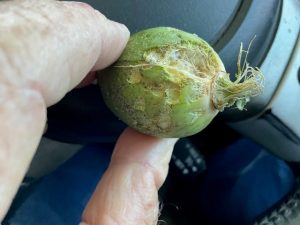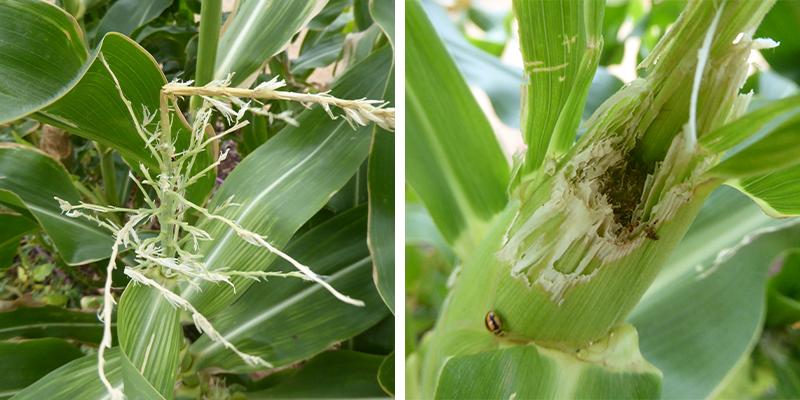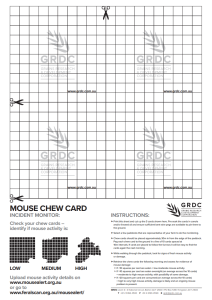
Mice damage to a cotton boll (photo by Roger Lindeman)
There have been reports of mice activity in some crops around the Central Highlands, including grain sorghum, mungbean and cotton.
Numbers of house mice (Mus domesticus) are generally low in cropping areas, but plagues can occur when conditions are favourable. Mouse populations have the potential to build rapidly and can do considerable damage in high numbers. Controlling plagues is both difficult and expensive, so early detection and integrated management across the farming system are crucial for reducing the damage risk.
Mice can feed on planted seed or emerging seedlings or in more mature crops, chew the growing nodes or developing grain. They will also feed on the seeds of many native grasses. If their food contains more than 15% moisture they can survive without access to water. They breed rapidly, becoming reproductive at about 6 weeks and can produce up to a dozen litters per year.
Minimum till and stubble retention farming systems may provide more opportunities for mice to find food and shelter, allowing carryover between seasons.

Mouse damage to corn tassels and cobs (photos by Tonia Grundy)
Monitoring for mice

Chew cards are useful for monitoring when food is scarce. Check for active burrows by sprinkling corn flour around the entrance and looking for disturbance. More details on these methods are available at the GRDC website.
Control options
Predators of mice (including foxes, feral cats, snakes and birds of prey) are unlikely to have a noticeable effect once plague numbers start to build.
Minimise sources of food and shelter. Keep grain storage areas clean, control weeds and volunteer plants in non-crop areas and minimise grain spills at harvest to reduce the amount of food available between crops.
Most rodenticides are approved for use around buildings and grain storage areas rather than in-crop. Check the APVMA’s PubCRIS database for registered product options for your situation.
Permit PER90799 (expires December 2023) allows the use of zinc phosphide for mouse baiting by persons authorised or licenced to use Schedule 7 poisons. For more details, download the permit from the APVMA website.
CSIRO’s Steve Henry has presented at recent GRDC updates on some experiments looking at using zinc phosphide for mouse control, finding that baits mixed with the higher permit rate are more effective. Read his update paper.
In Queensland, the house mouse is not a prohibited or restricted invasive animal under the Biosecurity Act 2014. However, by law, everyone has a general obligation to take reasonable and practical steps to minimise the risks associated with invasive animals under their control.
Also keep an eye out for soil pests this year
The conditions that have encouraged mice may also lead to higher establishment pest numbers this year. Monitor for the presence of soil pests before planting winter crops, particularly in fields with a history of damage.
Read the Beatsheet’s page on soil and establishment pests.
Further information
Mice and their management
- Mouse management (GRDC)
- House mouse (DAF)
- Mouse management (NSW DPI)
MouseAlert is a free resource at the Feralscan website that you can use to record and report the prevalence of mice before they become a major issue.
